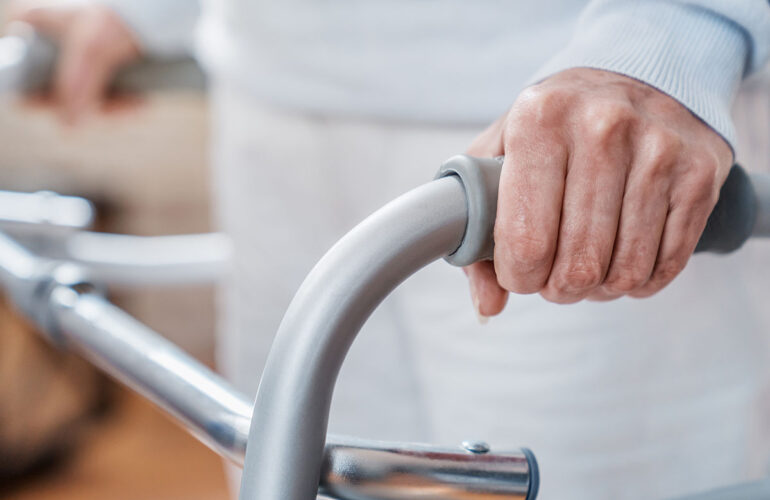Falls increase with age and occur more often in skilled nursing than in any other setting. Despite good care, falls appear to be inevitable due to advanced age, frailty, cognitive decline and medical complexity of older nursing home residents. Falls must be taken seriously, though, because they are a leading cause of morbidity, poor quality of life and mortality. Because of this, careful attention must be provided to causes of falls and effective methods to reduce or prevent them.
By the Numbers
Falls are so common and serious among older adults and seniors that they are tracked and monitored by various organizations around the world. The World Health Organization reports that between 30% to 50% of people 65 years of age and older have at least one fall annually and another 40% are repeat fallers. Skilled nursing communities around the United States have a fall rate three times higher than community settings, where seniors live in their own homes. It’s also reported that over half of nursing home residents fall more than once every year.
Consequences of Falls
Obviously, a fall can cause physical impairment or injury, but many times it’s not the fracture or bruising that causes the most problems for seniors. It is instead, the psychological and emotional effects of falling that place great burdens including depression and anxiety, a fear of falling again, loss in confidence, isolation and withdrawal and a general decrease in quality of life. Beyond physical and emotional consequences, there is a steep economic burden to the health care system through longer and more frequent hospitalizations.
Three Major Causes of Falls in Senior Care
Any number of factors can lead to increased risk for falls in skilled nursing (or any other setting). Such risks can be grouped into three categories, namely, intrinsic or internal factors, extrinsic or external factors and behavior-associated factors. In reality, falls probably occur due to a combination of these factors, making interventions even more challenging.
- Intrinsic factors associated with falls include illnesses, diseases and disorders the older adult has been diagnosed with along with advanced age and cognitive decline. Adding these factors together alone create great risks for falls.
- Extrinsic factors are found in the individual’s immediate environment including their room, hallways, and common areas throughout the nursing home. Another external variable of importance is the type and number of medications the individual has been prescribed. It’s common knowledge that many medications come with risk factors including lightheadedness, dizziness, and fatigue.
- Behavioral variables that increase risk of falls include impulsivity related to psychiatric illnesses (i.e. schizophrenia and other psychoses), or an overreliance on assistive devices due to an extreme fear of falling. Either way, the experience or illness that underlies the behavior can be a root cause of falls and should be identified and addressed in the plan of care.
Fall Reduction and Prevention Strategies
Because the rate and negative consequences of falls are significant, especially in skilled nursing facilities, reduction and prevention programs and interventions are not only greatly needed, but they need to be successful. In other words, it’s not enough to simply have fall prevention programs. What is needed most are effective programs that will either reduce the incidence of falls or prevent them altogether for the majority of residents.
Effective fall prevention strategies are methods or techniques implemented by staff and include:
- Fall audits to determine scope of the problem
- Training and education
- Environmental modification
- Establishing a fall committee
How Effective Are These Interventions?
According to various studies, methods such as these can reduce the number of falls among residents who have never fallen as well as those who fall frequently. Training and education appear to be the most effective strategy in reducing falls, followed by exercise with a balance component among residents. Vitamin D supplementation can also help to reduce the rate of falls.
Reducing Barriers to Successful Fall Reduction and Prevention Programs
Sometimes, fall programs will only be as successful as the employees implementing the interventions. This involves identifying and removing any barriers that may impede success. Such barriers include inadequate staffing (aka “working short”), heavy work loads, staff stress and burnout, poor training, poor communication among care staff and frustration with the effectiveness of their fall program. To maximize the effectiveness of any fall program, management must identify anything that can get in the way of its success and improve or eliminate it.
Final Thoughts on Falls Prevention in Senior Care
To fall is human, and more falls take place in the final quarter of life. Most likely, more falls will take place in senior care, and carry more burdensome consequences. Because of this, fall reduction and prevention programs are not only a must, but they need to be successful. It’s true that falls can cause a lot of physical and emotional pain, but they are also a leading cause of death and disability. Unfortunately, one fall may be all it takes, so programs have got to be spot on.

